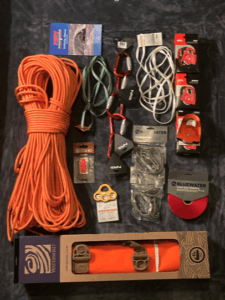In Between A Rock and a Wet Place:
Is Your Pin Kit Adequate?
Accidents happen. How we prepare for and resolve those situations affects how the tale is told. Getting a boat unpinned is a fundamental skill for river runners. The equipment used is also critical to your safety and success. Folks often just buy a commercially available pin kit and hope that it will suffice- it rarely does.
The pin kit you bring should not be for show. Your kit should be built to use in the situations you might face. Questions you should ask: How wide is the river? What is the flow? Are the shorelines vegetated or rocky? Is your pin kit built for what you do? Do you have one ready?
Scenario:
You are on a multi-day float down the Middle Fork of the Salmon River. A member of your crew breaks an oar going into Haystack Rapid, misses their line, and ends up pinned on a rock. They have most of the kitchen, that night’s meal, and libations on board. The river is over 250 feet wide at the scenario location and the boat is a good 100 feet from the nearest shore. Thankfully your group has a pin kit and it is properly stored on the sweep boat. The kit is deployed, and you somehow get a rope out to the stuck raft and tie it off. You go back to an solid anchor far up the shore. As you set up a Z-drag you notice you are out of rope. The kit you bought only had 150 feet (the standard in a commercial kit). How did you run out of rope?
Well, rivers can be big, anchors are rarely where you would like them to be, the “Z” portion of the drag reduces your line length up to 1/3, and when using a ½” static line (also standard), the tying of a Figure-8 on a bight uses 4’ of rope alone. This means most of us are not bringing the tools we need to do the job. Yes, a pin kit is better than no kit at all, but we think it is better to be prepared for the worst possible outcome.
So what should a pin kit look like? The answer is that it depends:
It depends on:
- Your type of craft
- What type of water you’re running
- What is the river flow
- What is the topography an landscape
Here are my thoughts and what I carry:
1. Rope
Do you need a half inch rope? Most likely no. Some half inch static can handle nearly 10,000 lbs. of load (40 KN). While it is nice to have that extra strength, my experience is that rather than pulling harder when the boat is not moving, I try pulling from a different angle. I have made the choice to carry a 9 mm rope with a 5,000 lb (22KN) rating. This allows me to carry 330 feet of rope in the same space and same weight of only 150 feet of ½ inch line.

2. Webbing
Anchors are hard to find and build, they can fail and seriously injure people. Bring more than 10’ of tubular webbing. Wrapping trees and rocks take way more material than you may think. Consider manufactured slings; they are stronger, lighter, and use less material. The only down side is they are more expensive. I carry 25 feet of 1 inch tubular webbing, a 10 foot 13mm Dynex Rabbit Runner and a 240 cm 10 mm Dynex sling. I like to have options.
3. Prusiks
Most kits come with the appropriate lines to make your own, if not, ensure you have the proper size line. It should be 70-80% the diameter of your haul line. Tie your Prusiks before you need them or purchase pre-sewn Prusiks. Pre-sewn Prusiks are stronger and easier to use.
4. Pulleys
Pulleys are crucial to gain the mechanical advantage you often need. Pin kits often come with two very low quality Prusik Minding Pulleys (PMPs). Make sure the Pulleys are PMP style, it will make things much safer and easier for your team. Consider carrying a minimum of three pulleys so you can redirect your pull. This will further protect your team or allow you to add additional mechanical advantage if you lack people to help.
5. Carabiners
Ensure you have dedicated carabiners in your kit. These should be locking carabiners and only use them for the pin kit. Dropping, cross loading, and irregular use all contribute to carabiner failure. Don’t use your water bottle carabiner or any non-rated carabiner for rescue work!
6. Take Care of Your Gear!
You need your safety gear to perform when it matters. Do not store your gear wet. The rope breaks down in water and sun. Pulleys get clogged with sand. And even aluminum carabiners can corrode if left wet.
7. Get a dedicated Gear Bag!
Get a dedicated bag for your kit. I personally got fancy and went with a Watershed dry bag. Why did I decide to drop so much money on a bag for my kit? The reason is a dry bag keeps my rope dry all the time so I do not have to dry it when I get done with every trip, the gear is free of sand, and IT FLOATS! I can also store it where I can get to it quick.
Most boat shops will be able to help you navigate the fine details of the gear you need and many climbing shops will have those tools as well. Yes, a commercially available pre-built pin kit is great, but be sure to consider customizing or adding to your kit so you aren’t short when you need it most.
If you have questions or need assistance obtaining quality components please feel free to reach out to us- [email protected] or [email protected]
“Whether you are a river-rookie or an experienced boater, WRI tailors their classes to what you need to learn in a fun and challenging environment. Their scenario based teaching approach creates an electric learning atmosphere where you feel like you are in actual river rescue situations. I would recommend them to anybody!”
